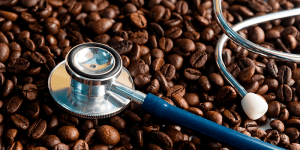Efectos del consumo de café en la hepatitis C crónica
28-04-2017
El consumo de café se ha asociado a una reducción en el riesgo de carcinoma hepatocelular en pacientes con hepatitis C crónica. Esta investigación tiene como objetivo estudiar los mecanismos mediante los cuales el café ejerce sus efectos protectores, en particular en términos del daño oxidativo en el ADN en relación a la inflamación hepática, la longitud de los telómeros, la fibrosis, apoptosis, angiogénesis y la carga viral. El estudio es un ensayo clínico aleatorizado tipo crossover. Cuarenta pacientes diagnosticados con hepatitis C crónica fueron aleatorizados en dos grupos: el primero consumía cuatro tazas de café al día por treinta días mientras que el segundo se mantenía abstinente. En el día treinta, los grupos se intercambiaban y recibían el tratamiento opuesto durante un segundo mes del estudio. Se encontró que los niveles de aminotransferasas (ALT y AST) eran menores en los pacientes que consumían 3-5 tazas (Grupo B) que en los que consumían 0-2 tazas al día (Grupo A) (56 ± 6 vs 74 ± 11/60 ± 3 vs73 ± 7 U/L p = 0.05/p = 0.04, respectivamente). Por su parte, los niveles de RNA del virus VHC fueron significativamente mayores en el grupo B [(6.2 ± 1.5) × 105 vs (3.9 ± 1.0) × 105 UI/mL, p = 0.05]. Durante la ingesta de café, los niveles de 8-hydroxideosiguanosina y colágeno fueron significativamente más bajos que durante la abstinencia. La longitud de los telómeros fue significativamente mayor durante la toma de café. En resumen, en hepatitis C crónica, el consumo de café induce una reducción en el daño oxidativo, que se relaciona con aumento en la longitud de los telómeros y apoptosis, y con mejor síntesis de colágeno, factores que probablemente median los efectos protectores del café sobre la progresión de la enfermedad.
Cardin R., Piciocchi M., Martines D., Scribano L., Petracco M., Farinati F. Effects of coffee consumption in chronic hepatitis C: A randomized controlled trial. Dig Liver Dis. 2013 Jun;45(6):499-504.
[12] Lv X, Chen Z, Li J, et al. Caffeine protects against alcoholic liver injury by atten- uating inflammatory response and oxidative stress. Inflammation Research 2010;59:635–45.
[13] Gressner OA, Lahme B, Siluschek M, et al. Identification of paraxanthine as the most potent caffeine-derived inhibitor of connective tissue growth factor expression in liver parenchymal cells. Liver International 2009;29:886–97.
[14] Um HJ, Oh JH, Kim YN, et al. The coffee diterpene kahweol sensitizes TRAIL- induced apoptosis in renal carcinoma Caki cells through down-regulation of Bcl-2 and c-FLIP. Chemico-Biological Interactions 2010;186:36–42.
[15] Farinati F, Cardin R, Bortolami M, et al. Hepatitis C virus: from oxygen free radicals to hepatocellular carcinoma. Journal of Viral Hepatitis 2007;14:821–9. [16] FarinatiF,CardinR,DeganP,etal.OxidativeDNAdamageincirculatingleuko- cytes occurs as an early event in chronic HCV infection. Free Radical Biology
and Medicine 1999;27:1284–91.
[17] Pal S, Polyak SJ, Bano N, et al. Hepatitis C virus induces oxidative stress, DNA
damage and modulates the DNA repair enzyme NEIL1. Journal of Gastroenter-
ology and Hepatology 2010;25:627–34.
[18] Farinati F, Cardin R, De Maria N, et al. Iron storage, lipid peroxidation and glu-
tathione turnover in chronic anti-HCV positive hepatitis. Journal of Hepatology
1995;22:449–56.
[19] Bortolami M, Kotsafti A, Cardin R, et al. Fas/FasL system, IL-1beta expression
and apoptosis in chronic HBV and HCV liver disease. Journal of Viral Hepatitis
2008;15:515–22.
[20] Farinati F, Cardin R, Bortolami M, et al. Oxidative damage, pro-inflammatory
cytokines, TGF-alpha and c-myc in chronic HCV-related hepatitis and cirrhosis.
World Journal of Gastroenterology 2006;12:2065–9.
[21] Farinati F, Cardin R, Fiorentino M, et al. Imbalance between cytoproliferation
and apoptosis in hepatitis C virus related chronic liver disease. Journal of Viral
Hepatitis 2001;8:34–40.
[22] Farinati F, Cardin R, Bortolami M, et al. Up and down regulation of apoptosis in
hepatitis C virus-related liver damage. Journal of Hepatology 2004;41:883–5. [23] Kotsafti A, Farinati F, Cardin R, et al. Bax inhibitor-1 down-regulation in the
progression of chronic liver diseases. BMC Gastroenterology 2010;10:35.
[24] Chuma M, Hige S, Nakanishi M, et al. 8-Hydroxy-2′-deoxy-guanosine is a risk factor for development of hepatocellular carcinoma in patients with chronic hepatitis C virus infection. Journal of Gastroenterology and Hepatology
2008;23:1431–6.
[25] OikawaS,KawanishiS.Site-specificDNAdamageatGGGsequencebyoxidative
stress may accelerate telomere shortening. FEBS Letters 1999;453:365–8. [26] Artandi SE, DePinho RA. Telomeres and telomerase in cancer. Carcinogenesis
2010;31:9–18.
[27] Rudolph KL, Hartmann D, Opitz OG. Telomere dysfunction and DNA damage
checkpoints in diseases and cancer of the gastrointestinal tract. Gastroenter-
ology 2009;137:754–62.
[28] Zani C, Donato F, Chiesa M, et al. Alcohol and coffee drinking and smok-
ing habit among subjects with HCV infection. Digestive and Liver Disease
2009;41:599–604.
[29] Witko-Sarsat V, Friedlander M, Capeillère-Blandin C, et al. Advanced oxida-
tion protein products as a novel marker of oxidative stress in uremia. Kidney
International 1996;49:1304–13.
[30] Cawthon RM. Telomere measurement by quantitative PCR. Nucleic Acids
Research 2002;30:e47.
[31] Fontana RJ, Lok AS. Noninvasive monitoring of patients with chronic hepatitis
C. Hepatology 2002;36:S57–64.
[32] Cheong JY, Kim DJ, Hwang SG, et al. Serum markers for necroinflammatory
activity in patients with chronic viral hepatitis and normal or mildly elevated
aminotransferase levels. Liver International 2011;31:1352–8.
[33] PellegrinoDA,XuHL,VetriF.Caffeineandthecontrolofcerebralhemodynam-
ics. Journal of Alzheimer’s Disease 2010;20:S51–62.
[34] Deltenre P, Corouge M, Canva V, et al. Usefulness of viral kinetics for early
prediction of a sustained virological response in HCV-1 non-responders re-treated with pegylated interferon and ribavirin. Journal of Hepatology 2011;55:989–95.
[35] Massard J, Ratziu V, Thabut D, et al. Natural history and predictors of disease severity in chronic hepatitis C. Journal of Hepatology 2006;44:S19–24.
[36] Choi MJ, Park EJ, Oh JH, et al. Cafestol, a coffee-specific diterpene, induces apoptosis in renal carcinoma Caki cells through down-regulation of anti- apoptotic proteins and Akt phosphorylation. Chemico-Biological Interactions 2011;190:102–8.
[37] KrystonTB,GeorgievAB,PissisP,etal.RoleofoxidativestressandDNAdamage in human carcinogenesis. Mutation Research 2011;711:193–201.
[38] MoriyaK,NakagawaK,SantaT,etal.Oxidativestressintheabsenceofinflam- mation in a mouse model for hepatitis C virus-associated hepatocarcinogenesis. Cancer Research 2001;61:4365–70.
[39] MisˇíkM,HoelzlC,WagnerKH,etal.Impactofpaperfilteredcoffeeonoxidative DNA-damage: results of a clinical trial. Mutation Research 2010;692:42–8.
[40] Valva P, Casciato P, Diaz Carrasco JM, et al. The role of serum biomarkers in predicting fibrosis progression in pediatric and adult hepatitis C virus chronic infection. PLoS ONE 2011;6:e23218.
[41] Molloy JW, Calcagno CJ, Williams CD, et al. Association of coffee and caffeine consumption with fatty liver disease, non-alcoholic steatohepatitis, and degree of hepatic fibrosis. Hepatology 2012;55:429–36.
[42] Cronstein BN. Adenosine receptors and fibrosis: a translational review. F1000 Biology Reports 2011;3:21.
[43] Horrigan LA, Kelly JP, Connor TJ. Immunomodulatory effects of caffeine: friend or foe? Pharmacology & Therapeutics 2006;111:877–92.















